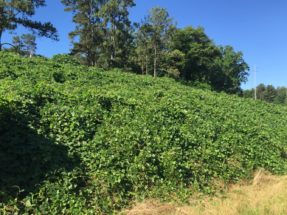South Carolina Invasive Plants
The more you understand about invasive plants, the better you can help the South Carolina Native Plant Society with our mission to control and eradicate invasive plants. Here is some helpful information on invasive species and how you can help.
Invasive Species
Invasive species are non-native organisms that are detrimental to our natural areas or native flora and fauna. Plants, insects, fungi, and vertebrates are the most common types of invasive species, though any type of organism can be invasive. Managing these pests often costs landowners, land managers, and taxpayers millions of dollars each year. Invasive species contribute to the loss of habitat for native species and contribute to their declines.
Invasive Plants
The climate and wide variation in habitat types in South Carolina supports a rich diversity of native plants throughout the state. This same rich environment can support many species of plants from around the world. Some of these non-native plants are beautiful and are commonly used as horticultural or landscape plants. In some cases, non-native plants may even be useful. Useful non-native plants include many of the foods we eat, such as potatoes, corn, and some fruit trees, like figs. Some non-native plants, however, become detrimental invasive species once they escape cultivation. These species are fierce competitors, outcompeting native plants for water, sunlight, and nutrients, and threaten South Carolina’s native biodiversity and ecosystems. Living in the South, we’re all familiar with Kudzu, but there are many more species which have found their way into our state and are having a major economic impact.
Invasive plants create serious environmental problems. Without the natural controls found in their place of origin, invasive plants move quickly into agricultural and natural areas. In the home garden they can become a significant weeding chore, but their infiltration into agricultural and natural areas is a disaster for land stewards and a financial drain for both farmers and consumers. In natural landscapes, waterways and recreation areas are impacted by decreased quality of animal habitat and increased risk of wildfires as invasive weeds take over and crowd out native vegetation. The costs to manage the problem are overwhelming. Invasive weeds are the second greatest threat to biodiversity and ecosystems after human caused habitat destruction.
How You Can Help Stop the Spread of Invasive Plants
SCNPS supports control – and where possible – eradication of invasive weeds. The most important and economical way to control invasive plants is to prevent their introduction. While the SCDNR maintains programs to prevent the introduction of pest plants, it is up to all of us to prevent the introduction and spread of invasive species. Seeds, as well as entire plants, must not be brought into the state unless they are in compliance with quarantine regulations. We also encourage residents to carefully consider any non-native plant they might be considering planting in their yard or garden. Experts at SCNPS or Clemson Extension are happy to discuss potential risks and implications of planting a non-native species.
Early Detection with Rapid Response is the second most important and economical method of controlling invasive plants. “Eliminate them before they spread” is a sound strategy when dealing with invasive plants. This is another area where you can help – if you see a non-native plant that has escaped into natural or unmanaged areas, report it to state officials.
You can also help stop the spread of invasive plants by being careful with clothing and equipment that has been worn or used when traveling from one area to another. Vehicles, animals and pets, and clothing can carry invasive plant seeds or propagules (parts of a plant that can grow a new one, like a root fragment) from here to there. Make sure that any nursery stock you buy (or sell) is free of invasive plant propagules.
Most of all, remember that many invasive plants begin as ornamental introductions sold in garden centers and nurseries. You can help control the spread of invasive weeds by not purchasing and planting seeds or plants in your own yard that are known to be invasive in the wild. The South Carolina Exotic Plant Pest Council (SC-EPPC) website lists commonly used plants that are known invasive species and the Homeowner’s section of this website suggests alternative plants to use in private or public landscapes.
Written by Dr. David Coyle, Clemson University


